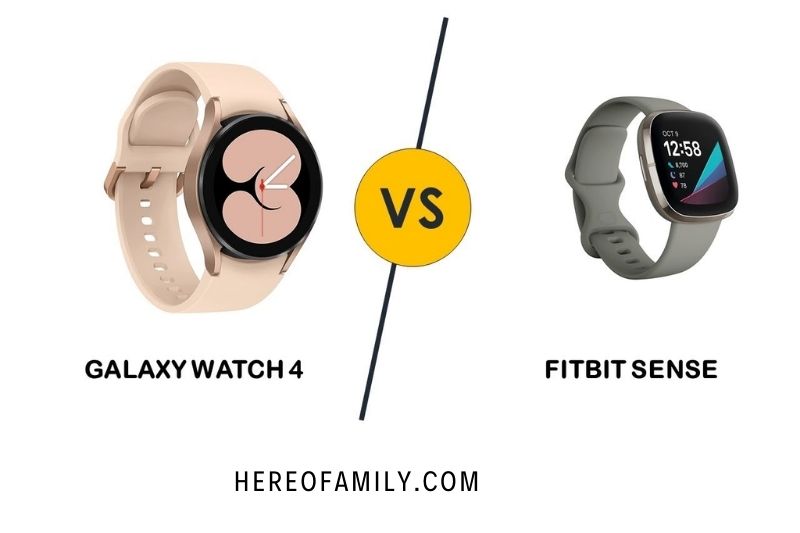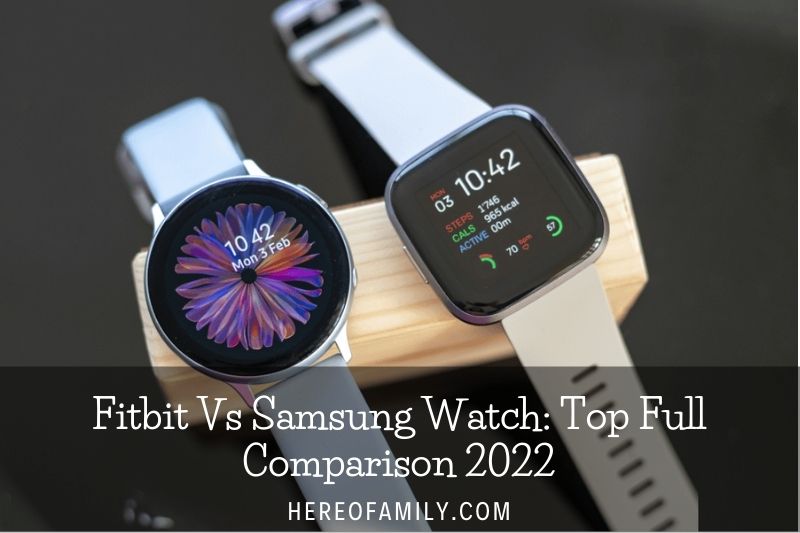When it comes to fitness trackers, there are two clear leaders in the market: Fitbit vs Samsung watch. Both brands offer a variety of features and options to fit different budgets and needs. But how do they compare when pitted against each other? In this article, we’ll look at the Samsung watch vs. Fitbit to help you decide.
Contents
Fitbit Vs Samsung Watch: Which Should You Buy?

Price
To begin with the obvious, the Fitbit Sense costs $299.95, while the Samsung Galaxy Watch 4 begins at $249.99. That’s a difference of around $50 without considering all of the various add-ons for Samsung’s newest wristwatch.
The regular Galaxy Watch 4 in 40mm size without LTE is the most cost-effective method to obtain a smartwatch on your wrist. The 40mm LTE variant costs $299.99, while the 44mm model costs $279.99 without LTE and $329.99 with LTE.
You might also go with the Galaxy Watch 4 Classic. The more expensive Galaxy Watch 4 models begin at $349.99 for the 42mm Bluetooth variant and $399.99 for the 42mm LTE model. The 46mm model costs $379.99 for Bluetooth and $429.99 with LTE.
Design and display
The Samsung Galaxy Watch 4 and Fitbit Sense are quite different in design. The new Galaxy Watch 4 series resembles a classic watch, particularly with the Classic model’s actual revolving bezel and stainless steel casing. The Fitbit Sense is a sporty-looking squircle like the Apple Watch 6 and all prior Apple Watch models.
Unlike the Apple Watch (and, for that matter, the Galaxy Watch 4), the Fitbit Sense lacks prominent buttons. Instead, capacitive touch controls are provided on the right side. From our perspective, it’s a fairly slick effect.
The 1.58-inch AMOLED display on the Sense has a resolution of 336 × 336 pixels. This is less than the Samsung Galaxy Watch 4’s, which begins at 396×396 pixels for the smallest watch size and increases to 450 x 450 pixels for the bigger selections. Most people won’t notice the difference, yet the Galaxy Watch’s display is much clearer when comparing the two watches side by side.
Both watches allow for customization via color selections and watch straps. The Galaxy Watch 4 and Fitbit Sense are both available in various metallic finishes. Furthermore, you may change out the provided bands with ones that match your unique style at any moment.
Fitness and health-tracking features
![]()
For the first time, Samsung introduces several new sensors to its smartwatch lineup with the Galaxy Watch 4, including an optical heart rate sensor (8PD), an electrical heart sensor (ECG), and biological impedance analysis (BIA).
These allow users to monitor a range of things, including their sleep, blood-oxygen level, blood pressure, and body fat percentage. The gadget also allows users to monitor over 100 different exercises, making it a real competitor to most other smartwatches.
Even though it is billed as a health and fitness watch, this includes the Fitbit Sense. Like the Watch 4, the Sense contains an ECG and red and infrared sensors for measuring oxygen saturation (SpO2).
For example, this means you can use it to track your heart rate and blood oxygen levels, but the selection of possibilities isn’t as wide as the Watch 4. Still, the Sense has an EDA sensor that can measure stress levels, and although it does need a Fitbit Premium membership (albeit new users get a free trial), it is a useful tool.
Battery life
The Samsung Galaxy Watch 4 has a 247mAh battery in the 40mm variant and a 361mAh battery in the 44mm model. This equates to around two days of battery life if you’re a heavy user using sleep-tracking, workouts, Spotify, and other apps.
Fitbit advertises six days of battery life with the Fitbit Sense, but this is only true if you use the watch rarely. If you attempt to get the most out of it, including frequent use of its health and fitness functions and the always-on display, you’ll discover that the battery life is fairly comparable to that of the Galaxy Watch 4. This equates to around two days between charges, give or take, indicating another tie.
Software
Aside from health functions, the Samsung Galaxy Watch 4 and Fitbit Sense also provide a variety of communication and productivity options. Even though Google owns Fitbit, the Galaxy Watch is one of these two Wear OS smartwatches. Meanwhile, Fitbit Sense uses a proprietary operating system. The Wear OS capabilities on the Samsung Galaxy Watch 4 are more advanced and extensive, but Fitbit’s software is straightforward, simple, and ideal for first-time smartwatch users.
Similarly, Fitbit Sense receives more applications than the Samsung Galaxy Watch 4. You’re likely to learn Fitbit’s activity tracking app or Fitbit Premium with the Sense. Still, with the Galaxy Watch 4, you may discover the greatest running applications or exercise programs you currently use. Google’s suite of apps, including Google Maps and Google Play Music, is now available on the Galaxy Watch 4.
Google Assistant is one application that Samsung’s wristwatch conspicuously lacks. For the time being, Bixby is your sole choice for voice commands. The Fitbit Sense supports Google Assistant and Alexa (you may only activate one at a time), allowing you to ask your preferred AI from your wrist.
Now, let’s talk about some key contrasts in communication and compatibility. The Galaxy Watch 4 is only compatible with Android phones, but the Fitbit Sense is compatible with any of the finest phones, including iPhones. Both may be used to accept calls and respond to SMS, but only with a compatible Android phone. Yes, even if your Sense is linked to an iPhone.
In addition, the Galaxy Watch 4 supports LTE connectivity via a telecom operator for an extra charge, but the Fitbit Sense does not. Your Sense must constantly be connected to your phone to reflect notifications or activate your voice assistant. The Galaxy Watch 4 can function independently of a phone without reducing communication capabilities.
Some relevant posts:
- Vtech Kidizoom Smartwatch DX2: Is It Perfect For Kids?
- How To Install Sim Card Smartwatch: Step By Step Guide 2023
- How To Get Scratches Out of Smartwatch 2023? Top Full Guide
- Why Is My Smartwatch Not Connecting To My Phone 2023?
- How To Change Band On Smartwatch: Step By Step Guide 2023
- Galaxy Watch 4 Vs Classic: Top Full Comparison
- Galaxy Watch 3 Vs 4 2023: Top Full Guide
FAQ
What’s the difference between a Fitbit and a smartwatch?
A fitness tracker is a device that monitors your health and activities. As a fitness tracker, a smartwatch keeps you connected by providing alerts and updates to your wrist. There is a significant overlap between the two.
Can you text on a Fitbit?
The Fitbit Charge 3, Fitbit Charge 4, Fitbit Charge 5, Fitbit Ionic, Fitbit Luxe, Fitbit Sense, or Fitbit Versa series use rapid answers to send personalized responses to text messages and messages from certain applications. This functionality is presently only accessible on devices connected to an Android phone.
Can I connect my smartwatch to Fitbit?
Fitbit Connect is a free software program that syncs any Fitbit tracker or wearable data to your Fitbit dashboard. If your device does not support Bluetooth, you will need to utilize a wireless sync dongle to set up your Fitbit gadget.
Conclusion
With so many choices on the market, it can be hard to decide which wearable device is right for you. We’ll pit the Fitbit against the Samsung Watch to help you decide in this article.
